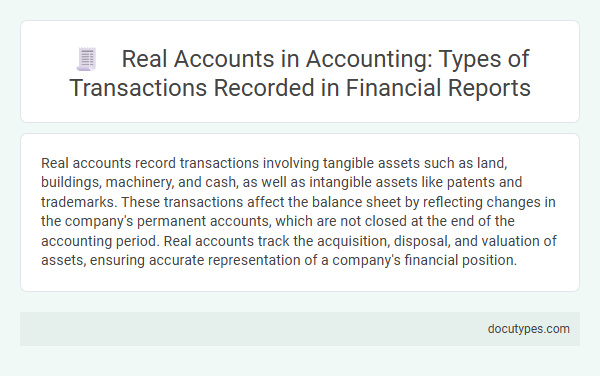Real accounts record transactions involving tangible assets such as land, buildings, machinery, and cash, as well as intangible assets like patents and trademarks. These transactions affect the balance sheet by reflecting changes in the company's permanent accounts, which are not closed at the end of the accounting period. Real accounts track the acquisition, disposal, and valuation of assets, ensuring accurate representation of a company's financial position.
Introduction to Real Accounts in Accounting
Real accounts are fundamental in accounting for tracking tangible and intangible assets. You need to understand the types of transactions recorded in real accounts to maintain accurate financial records.
- Asset Transactions - These include purchases, sales, or changes in ownership of tangible and intangible assets such as land, buildings, and patents.
- Capital Transactions - Transactions involving owner's equity or capital contributions are recorded in real accounts to reflect financial position.
- Liability Transactions - Real accounts also record obligations like loans or payables that affect an entity's financial status.
Definition and Characteristics of Real Accounts
| Definition of Real Accounts | |
|---|---|
| Real accounts represent permanent accounts related to assets, liabilities, and equity. These accounts maintain ongoing balances and are not closed at the end of an accounting period. | |
| Characteristics | Details |
| Nature | Record tangible and intangible assets, including cash, buildings, machinery, patents, and equity accounts. |
| Balance Continuity | Balances carry forward from one accounting period to the next without reset. |
| Transaction Types Recorded | Include purchase or sale of fixed assets, capital investments, depreciation, loans, and equity changes. |
| Account Examples | Cash Account, Land Account, Equipment Account, Capital Account, Loan Account. |
| Importance | Real accounts provide a clear picture of your organization's financial position by reflecting true asset holdings and equity. |
Importance of Real Accounts in Financial Reporting
Real accounts record transactions related to assets, liabilities, and equity, capturing the financial position of a business. These accounts are crucial in financial reporting as they provide a continuous record of tangible and intangible resources, enabling accurate balance sheet preparation. Understanding the importance of real accounts helps you maintain transparency and reliability in financial statements.
Types of Transactions Recorded in Real Accounts
Real accounts record transactions involving tangible assets and permanent accounts such as land, buildings, machinery, and cash. These transactions include purchases, sales, depreciation, and physical asset transfers that impact the company's financial position directly. Your accounting records rely on accurate entries in real accounts to maintain valid asset and liability balances over time.
Asset Accounts: Classification and Examples
Real accounts record transactions involving tangible and intangible assets owned by a business. These accounts provide a detailed classification of the company's resources, tracking changes in asset values over time.
Asset accounts include categories such as cash, accounts receivable, inventory, property, plant, and equipment. Examples are cash in hand, buildings, machinery, and patents, reflecting resources that contribute to your company's operational capacity and financial position.
Liability Accounts: Classification and Examples
What types of transactions are recorded in real accounts, specifically in liability accounts? Liability accounts track obligations a business owes to external parties. These transactions include loans, accounts payable, and accrued expenses, reflecting the company's debts and financial responsibilities.
How are liability accounts classified within real accounts? Liability accounts are divided into current liabilities, such as accounts payable and short-term loans, and long-term liabilities, including mortgages and bonds payable. This classification helps in assessing the company's short-term and long-term financial obligations.
Treatment of Real Account Transactions in Journals
Real accounts record transactions involving assets, liabilities, and capital. These accounts represent tangible and intangible items that your business owns or owes.
In journal entries, real account transactions are treated by directly recording increases or decreases in these accounts. When an asset is acquired, the real account is debited, and when disposed of, it is credited. Liabilities and capital accounts follow opposite rules, with credits increasing and debits decreasing their balances.
Impact of Real Accounts on Financial Statements
Real accounts record transactions involving assets, liabilities, and equity to reflect the company's financial position. These accounts impact financial statements by ensuring accurate representation of resources and obligations.
- Asset Transactions - Records additions and reductions to tangible and intangible assets affecting the balance sheet.
- Liability Transactions - Captures increases or decreases in obligations owed to creditors, influencing the company's debts reported.
- Equity Transactions - Reflects changes in owners' interest, including capital contributions and retained earnings affecting shareholder value.
Differences Between Real and Nominal Accounts
Real accounts record transactions involving assets, liabilities, and equity, reflecting actual resources owned or owed by a business. These accounts focus on tangible and intangible items that persist beyond a single accounting period.
- Real Accounts Represent Permanent Accounts - They carry balances forward to the next period, unlike nominal accounts which reset each period.
- Transactions Involve Physical or Financial Items - Examples include cash, machinery, buildings, and accounts payable.
- Nominal Accounts Track Income and Expenses - They record transactions related to revenue and costs that affect the profit and loss statement.
Your understanding of these distinctions ensures accurate financial record-keeping and reporting.
What Types of Transactions Are Recorded in Real Accounts? Infographic

